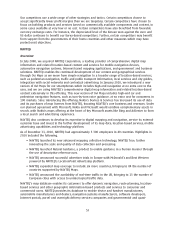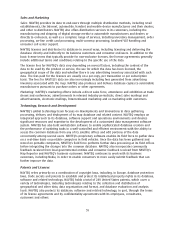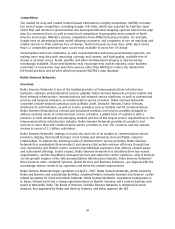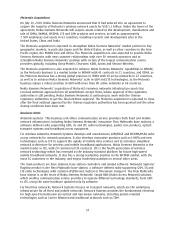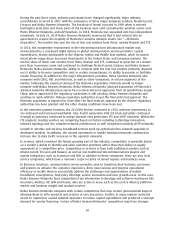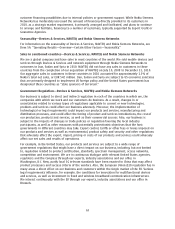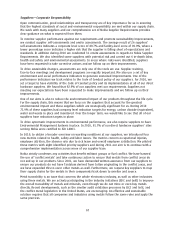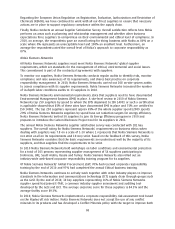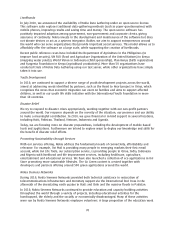Nokia 2010 Annual Report Download - page 63
Download and view the complete annual report
Please find page 63 of the 2010 Nokia annual report below. You can navigate through the pages in the report by either clicking on the pages listed below, or by using the keyword search tool below to find specific information within the annual report.During the past three years, industry participants have changed significantly. Major industry
consolidation occurred in 2007 with the emergence of three major European vendors, AlcatelLucent,
Ericsson and Nokia Siemens Networks. The breakup of Nortel occurred in 2009 when it entered
bankruptcy protection and many parts of the business were sold, including the wireless carrier unit,
Metro Ethernet Networks, and GSM business. In 2010, Motorola was separated into two independent
companies. On July 19, 2010 Nokia Siemens Networks announced that it had entered into an
agreement to acquire the majority of Motorola’s wireless network assets. See “—Motorola
Acquisition”. The market also saw the rise of low cost vendors from China, namely Huawei and ZTE.
In 2010, the competitive environment in the telecommunications infrastructure market was
characterized by a continued slight decline in global communication service providers’ capital
expenditures, mainly attributable to the Chinese, Indian and Middle East markets, while increased
smart phone usage drove increased investments in the United States and European markets. The
market share of lower cost vendors from China, Huawei and ZTE, continued to grow but at a slower
pace than in previous years and continued to challenge AlcatelLucent, Ericsson and Nokia Siemens
Networks. Nokia Siemens Networks’ ability to compete with the low cost vendors primarily depends
on its ability to be price competitive and, in certain circumstances, its ability to provide or facilitate
vendor financing. In addition to the major infrastructure providers, Nokia Siemens Networks also
competes with CISCO, NEC and Motorola, as well as other companies, in certain segments of the
market. Following the expected closing of the Motorola acquisition, Motorola would no longer
compete with Nokia Siemens Networks. Nokia Siemens Networks’ planned acquisition of Motorola’s
wireless networks infrastructure assets has received antitrust approvals from all jurisdictions except
China, where approval of the regulatory authorities is still pending. Nokia Siemens Networks will
continue to work with the Chinese regulatory authorities to get the final antitrust approval. The
Motorola acquisition is expected to close after the final antitrust approval by the Chinese regulatory
authorities has been granted and the other closing conditions have been met.
In the networks systems business, the 2G (GSM) decline continued in 2010, whereas investments to
3G continued and increased worldwide. Also, fourth generation (4G) LTE trials and pilots continued
strongly as operators continued to merge towards next generation LTE and allIP networks. Within the
LTE segment, leading vendors are competing based on factors including technology innovation,
network typology and less complex network architectures as well integration towards allIP networks.
Growth in wireline and wireless broadband services sped up optical/wireless network upgrades in
developed markets. In addition, the related investment in mobile backhaul networks continued to
increase due to data traffic increases in the operator networks.
In services, which remained the fastest growing part of the industry, competition is generally based
on a vendor’s ability to identify and solve customer problems rather than their ability to supply
equipment at a competitive price. Competition in services is from both traditional vendors such as
AlcatelLucent, Ericsson and Huawei, as well as nontraditional telecommunications players and
system integrators, such as Accenture and IBM. In addition to these companies, there are also local
service companies, which have a narrower scope in terms of served regions and business areas.
In Business Solutions, communication service providers seek to transform their business, processes
and systems to enhance the customer experience, drive new revenue and improve operational
efficiency to enable them to successfully address the challenges and opportunities of mobile
broadband, smartphones, multiplay offerings, service innovation and new growth areas. In this area,
Nokia Siemens Networks faces competition from information technology and software businesses like
Accenture, Amdocs, HP, IBM and Oracle, who are active in areas such as the service delivery platform
market and business insight and analysis services.
Nokia Siemens Networks competes with certain competitors that may receive governmental support
allowing them to offer products and services at very low prices. Further, in many regions restricted
access to capital has caused network operators to reduce capital expenditure and produced a stronger
demand for vendor financing. Certain of Nokia Siemens Networks’ competitors may have stronger
62



